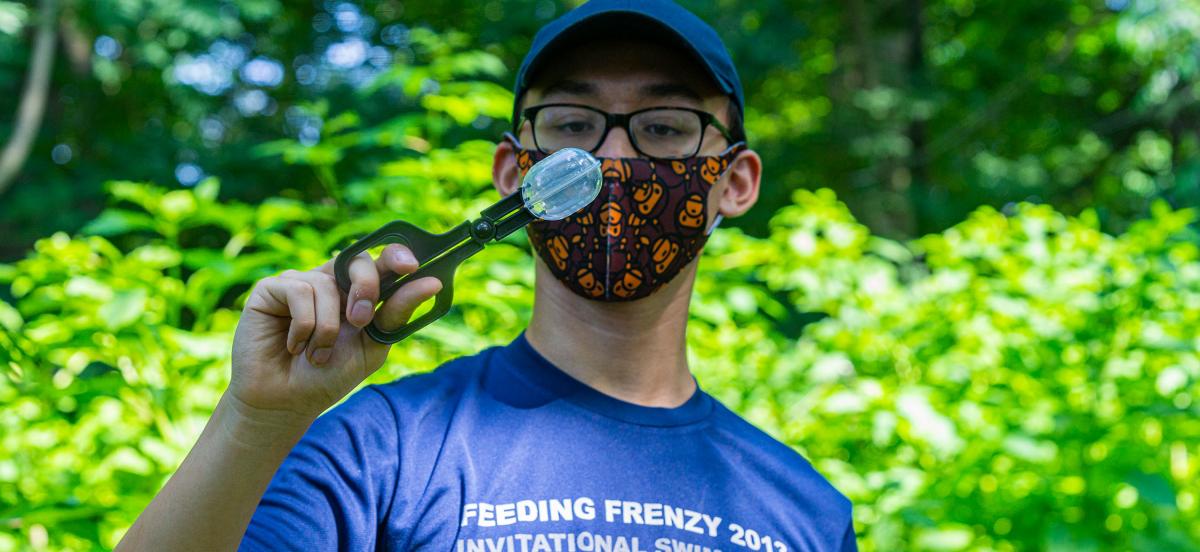Theo Bien '22 Unravels the Mysteries of An Invasive Species

Physics major Theo Bien ’22 is studying the biomechanics of the spotted lanternfly, an invasive insect species, on campus this summer. Photo by Patrick Montero.
Details
As part of a research project with Professor Suzanne Amador Kane, the physics major is spending his summer researching the biomechanics of spotted lanternflies.
Every summer Haverford’s Koshland Integrated Natural Sciences Center (KINSC) sponsors the scientific research of dozens of Fords, both on campus and across the country and globe. Though the coronavirus pandemic has necessitated a move to remote work for summer research assistants, there is at least one student scientist still using Haverford’s campus as his lab.
Physics major Theo Bien ’22 is studying the biomechanics of the spotted lanternfly, an invasive insect species. His work—conducted while wearing a mask and social distancing outside—includes finding specimens on campus and poking spotted lanternfly nymphs with bird and insect predator models on the Nature Trail.
Spotted lanternflies, which only recently arrived in Pennsylvania and whose numbers have skyrocketed locally due to their high rate of reproduction and lack of native predators, cause serious damage to trees by feeding on their sap and producing a sticky substance, called honeydew, that promotes the growth of mold that ruins produce. So uncovering how they travel and why they are able to avoid being eaten is important not only for science's sake, but also in service of the many local businesses growing food and flowers whose crops are destroyed by the insects.
“I am interested in this project because insect biomechanics fascinate me,” says Bien, who is also in Haverford’s joint 4+1 mechanical engineering program at the University of Pennsylvania. “For such small animals, [spotted lanternflies] are able to withstand and produce large amounts of force, travel surprisingly far, and possess incredible anti-predator responses to get themselves out of ‘sticky situations.’ If we can better understand how these animals create such force, we might be able to replicate these phenomena to improve the precision, durability, and abilities of robots. Also, through analysis of anti-predator responses we can take inspiration from nature to aid in planning disaster-relief efforts.”
This research is the continuation of work that Bien began earlier this year, before the campus shutdown, with Professor of Physics Suzanne Amador Kane. The professor, who has long studied biological physics, in particular the biomechanics of peacock mating displays and raptor prey pursuit, became interested in spotted lanternflies when they started destroying her home garden and damaging her red maple tree.
“One day I noticed a single spotted lanternfly on my porch and pondered how lovely it was,” remembers Amador Kane. “ The next morning they had coated my plants in swarms! As I swatted and killed them, I was torn between the competing desires to protect our new native garden plantings and to watch how interesting their behavior was. It suddenly hit me—I could study them next spring while endlessly removing them from my garden. That was of course well before the COVID-19 shutdown made any other project impossible.”
Amador Kane is now using Bien’s findings to film high-speed video of the insects’ anti-predator behavior, which another student, Luis Contreras-Orendain ‘21, is writing motion-analysis and machine learning software to process from home.
Though the summer is only halfway over, Bien says he has already learned a lot about performing full-time research and Amador Kane says the team already has enough data for a complete study of the early nymphal stages of the insect. She hopes to publish this research soon.
Another thing Bien says he learned this summer is the joys and efficiencies of intercollege collaboration, since this research has been done in partnership with colleagues at Temple University.
“While working with Professor Amador Kane, I have also learned about the benefits of open science which pushes us to make data and information accessible to all and promotes collaboration,” he says. “As projects become more and more complex, we need to share our resources and capabilities to promote proper and rigorous science.”



